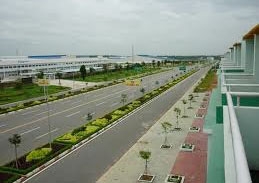Tokyu to develop traffic infrastructure in Binh Duong
 |
| illustration photo |
Takahashi Toshiyuki, executive officer of Tokyu Corporation, said the memorandum was aimed at developing a modern bus transit system and possibly a rail line connected to the inter-provincial transport system between Binh Duong and other areas in the Southern Key Economic Zone.
According to Toshiyuki, Binh Duong has a strategic position as a center of the Southern Key Economic Zone, with an annual GDP growth of 14-15 per cent, far exceeding the nation’s average level. Despite a population of 1.6 million over the total of 24 million residents in the southern region, the public transport infrastructure there is still full of shortcomings.
“From now onwards, drawing experience from the development of the urban area Tokyu Tama Denen in Japan, we and Becamex IDC will conduct survey and map out plan for inter-provincial transport system connecting Binh Duong and other areas in the Southern Key Economic Zone, with a focus on a modern bus transit system and a possibility to develop a railway route in the future,” said Toshiyuki.
Through this cooperation project, Tokyu makes a step further into Binh Duong province.
Earlier, the Japanese corporation had formed a joint venture with Becamex IDC to start work on Tokyu Binh Duong Garden City, covering over 71 hectares in Binh Duong New City. The project worth some VND25 trillion is sponsored by Japan’s Bank of Tokyo Mitsubishi UFJ.
Together with the memorandum signing, a ceremony was held in Binh Duong New City on Wednesday to celebrate the establishment of Thu Dau Mot City.
Thu Dau Mot achieved high economic growth of 23.3 per cent per year in the period from 2006 to 2010, which surged to 27.7 per cent in 2011, along with a significant shift towards the structure of service, industry and agriculture at 60.8 per cent, 38.9 per cent and 0.3 per cent respectively.
There are currently 11 commercial centers and supermarket and 13 traditional markets across the city, ensuring ample supply for local producers and consumers.
The average income per capita last year is VND49 million. The percentage of poverty-stricken households under new criteria is 2.54 per cent.
What the stars mean:
★ Poor ★ ★ Promising ★★★ Good ★★★★ Very good ★★★★★ Exceptional
Related Contents
Latest News
More News
- TD CASA and the rise of bespoke interior design in luxury living spaces (December 03, 2025 | 14:14)
- Lee Soo-man's Blooming Sky to build Gia Lai culture, sport, and entertainment complex (December 02, 2025 | 16:41)
- Sustainability in DNA of Keppel Vietnam's future urban development strategy (November 28, 2025 | 10:53)
- South Korean investors seek clarity on IP lease extensions (November 24, 2025 | 17:48)
- Streamlined administration boosts Vietnam's hotel investment prospects (November 21, 2025 | 19:13)
- Starlake emerges as Hanoi’s new Grade-A office hub (November 21, 2025 | 19:02)
- Vietnamese firms turn to TOD to modernise urban development (November 20, 2025 | 08:44)
- Government to propose Land Law draft easing land recovery procedures (November 17, 2025 | 17:53)
- Vinhomes Green Paradise joins 7 Wonders of Future Cities campaign (November 03, 2025 | 12:23)
- Radisson Hotel Group expands world-class hospitality across Vietnam (November 03, 2025 | 10:49)

 Tag:
Tag:





















 Mobile Version
Mobile Version